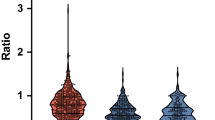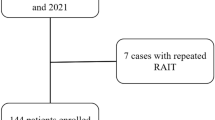Abstract
Purpose
Treatment with 131I-MIBG is associated with significant thyroid damage. This study was undertaken to investigate the long-term efficacy of current thyroid prophylaxis, to explore the relationship between thyroid dysfunction and thyroid volume after exposure to 131I-MIBG and to evaluate the possible negative effects of 131I− on the parathyroid glands.
Methods
Of 81 long-term surviving patients with neuroblastoma treated with 131I-MIBG during the period 1999–2012, 24 were finally evaluated. Patients received thyroxine (T4), methimazole and potassium iodide as thyroid protection. In all patients (para)thyroid function was evaluated and ultrasound investigation of the (para)thyroid gland(s) was performed. Thyroid dysfunction was defined as a plasma thyrotropin concentration >5.0 mU/L (thyrotropin elevation, TE) or as the use of T4 at the time of follow-up. Hyperparathyroidism was defined as a serum calcium concentration above the age-related reference range in combination with an inappropriately high parathyroid hormone level.
Results
At a median follow-up of 9.0 years after 131I-MIBG treatment, thyroid disorders were seen in 12 patients (50 %; 9 with TE, 5 with a thyroid nodule and 1 patient was subsequently diagnosed with differentiated thyroid carcinoma). No significant risk factors for the occurrence of thyroid damage could be identified. In 14 of 21 patients (67 %) in whom thyroid volume could be determined, the volume was considered small (<−2SD) for age and gender. Patients treated with T4 at the time of follow-up had significantly smaller thyroid volumes for age than patients without T4 treatment (p = 0.014). None of the patients was diagnosed with hyperparathyroidism.
Conclusion
Thyroid protection during treatment with 131I-MIBG needs attention and must be further improved, as thyroid disorders are still frequently seen despite current thyroid prophylaxis. Reduced thyroid volume in neuroblastoma survivors may be related to previous 131I-MIBG therapy or current T4 treatment. No deleterious effects of 131I-MIBG on the parathyroid glands could be found.




Similar content being viewed by others
References
Taggart D, Dubois S, Matthay KK. Radiolabeled metaiodobenzylguanidine for imaging and therapy of neuroblastoma. Q J Nucl Med Mol Imaging. 2008;52:403–18.
Giammarile F, Chiti A, Lassmann M, Brans B, Flux G. EANM procedure guidelines for 131I-meta-iodobenzylguanidine (131I-mIBG) therapy. Eur J Nucl Med Mol Imaging. 2008;35:1039–47.
Garaventa A, Guerra P, Arrighini A, Bertolazzi L, Bestagno M, De Bernardi B, et al. Treatment of advanced neuroblastoma with I-131 meta-iodobenzylguanidine. Cancer. 1991;67:922–8.
Clement SC, van Eck-Smit BLF, van Trotsenburg ASP, Kremer LCM, Tytgat GAM, van Santen HM. Long-term follow-up of the thyroid gland after treatment with (131)I-metaiodobenzylguanidine in children with neuroblastoma: importance of continuous surveillance. Pediatr Blood Cancer. 2013;60:1833–8.
Quach A, Ji L, Mishra V, Sznewajs A, Veatch J, Huberty J, et al. Thyroid and hepatic function after high-dose 131I-metaiodobenzylguanidine (131I-MIBG) therapy for neuroblastoma. Pediatr Blood Cancer. 2011;56:191–201.
Van Santen HM, de Kraker J, van Eck BLF, de Vijlder JJM, Vulsma T. Improved radiation protection of the thyroid gland with thyroxine, methimazole, and potassium iodide during diagnostic and therapeutic use of radiolabeled metaiodobenzylguanidine in children with neuroblastoma. Cancer. 2003;98:389–96.
Brans B, Monsieurs M, Laureys G, Kaufman J-M, Thierens H, Dierckx RA. Thyroidal uptake and radiation dose after repetitive I-131-MIBG treatments: influence of potassium iodide for thyroid blocking. Med Pediatr Oncol. 2002;38:41–6.
Van Santen HM, de Kraker J, van Eck BLF, de Vijlder JJM, Vulsma T. High incidence of thyroid dysfunction despite prophylaxis with potassium iodide during (131)I-meta-iodobenzylguanidine treatment in children with neuroblastoma. Cancer. 2002;94:2081–9.
Garaventa A, Bellagamba O, Lo Piccolo MS, Milanaccio C, Lanino E, Bertolazzi L, et al. 131I-metaiodobenzylguanidine (131I-MIBG) therapy for residual neuroblastoma: a mono-institutional experience with 43 patients. Br J Cancer. 1999;81:1378–84.
Matthay KK, DeSantes K, Hasegawa B, Huberty J, Hattner RS, Ablin A, et al. Phase I dose escalation of 131I-metaiodobenzylguanidine with autologous bone marrow support in refractory neuroblastoma. J Clin Oncol. 1998;16:229–36.
Picco P, Garaventa A, Claudiani F, Gattorno M, De Bernardi B, Borrone C. Primary hypothyroidism as a consequence of 131-I-metaiodobenzylguanidine treatment for children with neuroblastoma. Cancer. 1995;76:1662–4.
Picco P, Garaventa A, Claudiani F, Garibaldi L, Borrone C. Primary hypothyroidism and 131I-MIBG therapy in neuroblastoma. Lancet. 1993;342:57.
Van Santen HM, Tytgat GAM, van de Wetering MD, van Eck-Smit BLF, Hopman SMJ, van der Steeg AF, et al. Differentiated thyroid carcinoma after 131I-MIBG treatment for neuroblastoma during childhood: description of the first two cases. Thyroid. 2012;22:643–6.
Rosen IB, Palmer JA, Rowen J, Luk SC. Induction of hyperparathyroidism by radioactive iodine. Am J Surg. 1984;148:441–5.
Moore AF, Wexler TL, Yung RL, Kish J, Larvie M, Lauter K, et al. An unusual case of primary hyperparathyroidism with profoundly elevated parathyroid hormone levels. Endocr Pract. 2008;14:892–7.
Wiersinga WM, Podoba J, Srbecky M, van Vessem M, van Beeren HC, Platvoet-Ter Schiphorst MC. A survey of iodine intake and thyroid volume in Dutch schoolchildren: reference values in an iodine-sufficient area and the effect of puberty. Eur J Endocrinol. 2001;144:595–603.
George RE, Li S, Medeiros-Nancarrow C, Neuberg D, Marcus K, Shamberger RC, et al. High-risk neuroblastoma treated with tandem autologous peripheral-blood stem cell-supported transplantation: long-term survival update. J Clin Oncol. 2006;24:2891–6.
Masood MQ, Hakeem H. Isotretinoin associated reversible hypothyroidism. Thyroid. 2011;21:1039–40.
Veiga LHS, Bhatti P, Ronckers CM, Sigurdson AJ, Stovall M, Smith SA, et al. Chemotherapy and thyroid cancer risk: a report from the childhood cancer survivor study. Cancer Epidemiol Biomarkers Prev. 2012;21:92–101.
Bhatti P, Veiga LHS, Ronckers CM, Sigurdson AJ, Stovall M, Smith SA, et al. Risk of second primary thyroid cancer after radiotherapy for a childhood cancer in a large cohort study: an update from the childhood cancer survivor study. Radiat Res. 2010;174:741–52.
Wilson CL, Ness KK, Neglia JP, Hammond S, Shnorhavorian M, Leisenring WL, et al. Renal carcinoma after childhood cancer: a report from the childhood cancer survivor study. J Natl Cancer Inst. 2013;105:504–8.
Ricardi U, Corrias A, Einaudi S, Genitori L, Sandri A, di Montezemolo LC, et al. Thyroid dysfunction as a late effect in childhood medulloblastoma: a comparison of hyperfractionated versus conventionally fractionated craniospinal radiotherapy. Int J Radiat Oncol Biol Phys. 2001;50:1287–94.
Bonato C, Severino RF, Elnecave RH. Reduced thyroid volume and hypothyroidism in survivors of childhood cancer treated with radiotherapy. J Pediatr Endocrinol Metab. 2008;21:943–9.
Monzani A, Prodam F, Rapa A, Moia S, Agarla V, Bellone S, et al. Endocrine disorders in childhood and adolescence. Natural history of subclinical hypothyroidism in children and adolescents and potential effects of replacement therapy: a review. Eur J Endocrinol. 2013;168:R1–R11.
Acknowledgments
We thank Prof. dr. W.M. Wiersinga and Dr. J. Podoba for providing the reference value data on thyroid volumes in healthy Dutch schoolchildren.
Conflicts of interest
None.
Funding
No external funding.
Author information
Authors and Affiliations
Corresponding author
Electronic supplementary material
Below is the link to the electronic supplementary material.
ESM 1
(DOC 56 kb)
Rights and permissions
About this article
Cite this article
Clement, S.C., van Rijn, R.R., van Eck-Smit, B.L.F. et al. Long-term efficacy of current thyroid prophylaxis and future perspectives on thyroid protection during 131I-metaiodobenzylguanidine treatment in children with neuroblastoma. Eur J Nucl Med Mol Imaging 42, 706–715 (2015). https://doi.org/10.1007/s00259-014-2967-4
Received:
Accepted:
Published:
Issue Date:
DOI: https://doi.org/10.1007/s00259-014-2967-4




